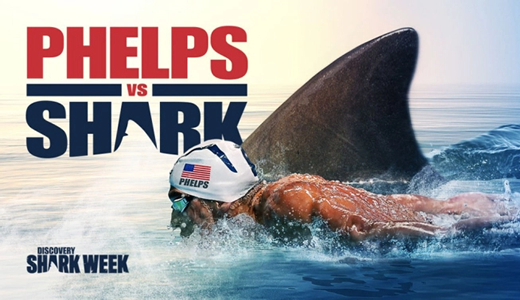Each summer, Discovery Channel faces a unique programming challenge: making its “Shark Week” programming feel fresh. That’s no small challenge, given the fact that this annual ode to dorsal fins and sharp teeth has been airing since 1988.
This year, the cable network began teasing one of its sharkiest gambits yet: pitting Olympic swimming legend Michael Phelps against a great white shark. I mean, who wouldn’t turn in for that race, right?
Many of those who did tune in, however, were angered by the actual “race.” It took place about 57 airtime minutes into the program, most of which focused on scientists (with Phelps’ cheerful help) gathering data to estimate a great white’s straight-line speed. Then the show pitted Phelps against a digital version of that data-generated shark. Result? Phelps lost—really, to no one’s surprise—against that special effects fish. And, at least in terms of viewer responses, so did Discovery, generating another megalodon-sized blowback for failing to have Phelps literally race a shark. Once again, Discovery (and Phelps) were forced into defending their shark-“race” special against claims that advertising for it had been deceptive.
On a much more serious note, Linkin Park frontman Chester Bennington took his own life last week. Shortly after the singer’s death, various news outlets began commenting on the fact that Bennington’s suicide occurred on the birthday of Soundgarden lead singer Chris Cornell, who also committed suicide in May. Bennington and Cornell had reportedly become close friends in the last decade. Bennington also performed Leonard Cohen’s “Hallelujah” at Cornell’s funeral. And he penned a poignant letter to his friend after Cornell’s death. In that letter, posted on Twitter, Bennington said, “Your talent was pure and unrivaled. Your voice was joy and pain, anger and forgiveness, love and heartache all wrapped up into one. I suppose that’s what we all are. You helped me understand that.”
Suicide continues to make the news in other ways lately, too. Conversation continues regarding the influence of the Netflix series 13 Reasons Why. Writing for The Federalist, Anna Mussmann discusses how our culture increasingly sees taking one’s life as a “noble death.” She says, “This idea that killing oneself is a source of power and strength has even been translated into popular entertainment. The YA novel and Netflix show 13 Reasons Why centers around the story of a teenager who has committed suicide, and could easily communicate the idea that the character’s death is what allows her to achieve the attention, understanding, and revenge she wanted but couldn’t get in life.”
As we noted in Culture Clips on June 7, the Centers for Disease Control and Prevention reported that suicides by 10- to 14-year-olds doubled between 2007 and 2014. Researchers who are continuing to parse that study believe economic uncertainty, terrorist threats, academic pressure and social media usage all have played a part in this alarming spike in suicides among children.
In a recent piece for The [Bergen Country, N.J.] Record republished by USA Today, James M. O’Neill expands upon the negative influence of social media: “The use of social media is a particular worry because it has amped up bullying among a vulnerable age group. Young students in prior generations left school each afternoon and avoided someone who bullied them until the next day or week. Now, social media allows for bullying 24/7—and the bully doesn’t even have to be someone the child knows.”
Glenn Geher, professor and chair of psychology at the State University of New York, concurs. In his Psychology Today article “The Mental Health Crisis is Upon the Internet Generation,” Geher says that recent research he conducted found that 59% of 200 college students surveyed reported being diagnosed with a psychological disorder—a figure he believes is closely linked to technology and smartphone usage.
Another recent apparent example of social media’s devastating influence on a young person is the suicide of 15-year-old Texan Jorge Gonzales, who hung himself on July 8. His parents believe that their son was influenced by the “Blue Whale Challenge.” USA Today reports this online trend “targets teens through Instagram, Facebook and Snapchat. The challenge involves an anonymous instructor telling teens to complete challenges, like listening to music. Many of the challenges quickly become dangerous like urging teens to harm themselves by cutting themselves.”
Meanwhile, new warnings have been issued regarding how internet-connected toys pose a privacy risk, as well as allegations that the robot vacuum Roomba may not only be sucking up dirt from your carpet, but also measuring your house’s rooms and sending that data on to marketers to use.
In more upbeat tech news, however, using emojis may actually improve our communication because they can make it easier to express emotion in texts. And in an unexpected development in our uber-wired new millennium, old-fashioned radio dramas are making a comeback.
Elsewhere, evidence continues to mount that playing professional football is potentially really bad for players’ brains, with 110 of 111 former players in a new study showing evidence of the brain disease known as chronic traumatic encephalopathy, or CTE, a degenerative condition caused by too many sharp blows to the head.
Finally this week, Christopher Nolan’s World War II movie Dunkirk is being characterized by some as his greatest film. And at least one moviegoer who was there at the time, a 97-year-old veteran of the battle, believes Nolan did it justice. “It was just like I was there again,” said Ken Sturdy, who was dressed in uniform and adorned with medals for the screening he attended. “It didn’t have a lot of dialogue. It didn’t need any of the dialogue because it told the story visually, and it was so real.”






Recent Comments